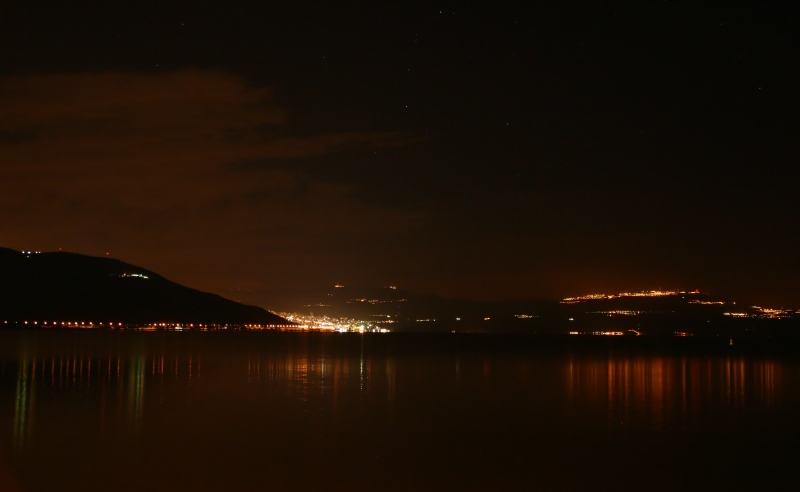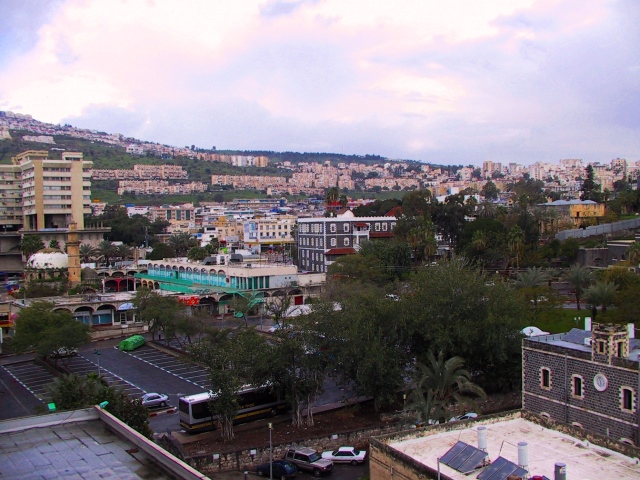|
|
|
|
|
|
|
|
|
|
|
Tiberias Tiberias is mentioned three times in Scriptures, all in the gospel of John. At the time of Jesus, Tiberias was a new city. Sources vary widely on the date of its' founding, some saying A.D. 14, others A.D. 16 or 20 and one as late as A.D. 26. It is safe to say that during the time of Jesus' public ministry, when he spent so much time traveling around Galilee, Tiberias was certainly only a few years old. The first century historian Josephus records the reason, location, and founder of this new city.
|

A night view of Tiberias looking across the Sea of Galilee.
|
Tiberias was located on the western side of the Sea of Galilee towards the southern end. Built in a small valley (about two miles long and a quarter mile wide), it was bordered by the sea and steep hills to each side. It was close to natural warm water (hot bath) springs notable to the ancients and still in existence today. Josephus likely provided the primary reason why Tiberias hardly is mentioned during Jesus' time, namely that Jews observing the law would have avoided having anything to do with it. The ancient Jewish law that would have been broken is as follows:
With all the time Jesus spent around Galilee, it is quite significant that Jesus is never recorded as having visited Tiberias. The gospels show that Jesus never broke the law. Certainly He was accused of doing so, but this was by the Pharisees who had added their own strict interpretation to it, perverting it by their traditions (Mark 7:6-8). Jesus perfectly keeping the law may be one such reason why he didn't enter Tiberias.
|

A
quick collage of Tiberias showing the Sea of Galilee to the hillside.
(Sorry
changing clouds and lighting kept this from being seemless)
|
Tiberias was not some insignificant city either. Immediately following its' founding it was proclaimed the capital city of the region, the seat of the government and it remained so until the time of Herod Agrippa II. History records that Herod tried hard to entice the Jews into accepting his city, perhaps the greatest being through the construction of a magnificent synagogue there. As home to Herod Antipas, Jesus likely avoided going there solely to stay away from Herod. It was not until Jesus' crucifixion that Herod got to see Jesus.
People from Tiberias, besides Herod, obviously were aware of Jesus. As a city on the shores of the Sea of Galilee, many would have been fishermen (Josephus mentions this too!) and boats available to them. This brings us to the account of John and one of his mentions of Tiberias...
In the days of Jesus, the lake was commonly known as the Sea of Galilee or the Sea of Gennesaret, both descriptive of its location. John, writing a number of years later, and knowing that his gospel would be read by many not familiar with the area, also used the name that Rome favored, the Sea of Tiberias. This name actually stuck and was used for centuries following. John's provision of an alternate wording is not unique in this circumstance as he quite commonly provides Greek translations of other Hebrew words and names throughout his gospel.
Later, in John's gospel, both names aren't given as He relies solely only on the new name.
The destruction of Jerusalem and the temple in A.D. 70 marked a new beginning for Tiberias, which had not been destroyed due to the favorable few its' residents had towards the Romans. After a few temporary stays, including at Sepphoris, the Sanhedrin ultimately made its' long term home at Tiberias in the second century following the Jewish uprising of A.D. 135. It's interesting that the religious rulers would compromise so greatly over Tiberias, a place they would have avoided half a century earlier, all because of circumstances. A number of important Jewish post temple documents came out of Tiberias including the Jewish Mishna (a binding code of civil and ritual laws, decrees and customs which was compiled in Tiberias circa A.D. 190 - 200), the Jerusalem Talmud and the writings of Maimonides, who died there in 1204 A.D. During the brief period that Christians controlled the area, Tiberias was the seat of a bishop. Beginning in 637 A.D., though, the city fell to the Muslims and changed hands a number of times until falling completely under Muslim control in 1247. Returning to New Testament times, another significant event likely took place at Tiberias though not specified by name.
John's imprisonment was likely in one of Herod's outposts close to where he had been ministering. The first century historian, Josephus, claims that it was at Machaerus, beyond the Jordan (Antiquities 18.5.2). On the other hand, Herod and Heordias normally resided at Tiberias. For this reason, it is not unlikely that the dance and request for John's head all took place at Tiberias (consider Mark 6:21). Even if the death sentence was carried out at place further away, his head could have been sent to the primary palace. It also may be that John, himself, had been transferred to Tiberias sometime prior. In Mark's gospel we are told, prior to the dance, that Herod liked listening to John, which presupposes that John may have been kept nearby.
|

Night view of Tiberias from the waterfront looking northwest

Day view of Tiberias from the waterfront looking northwest